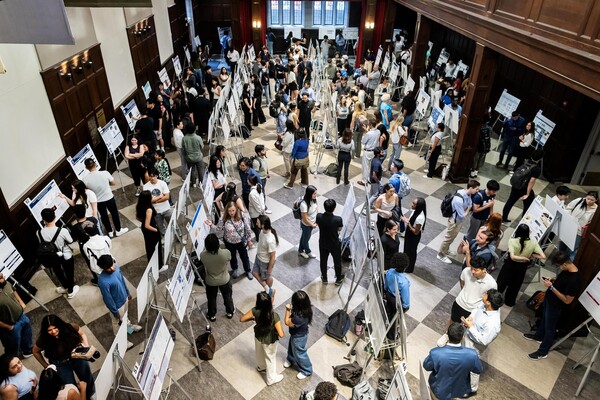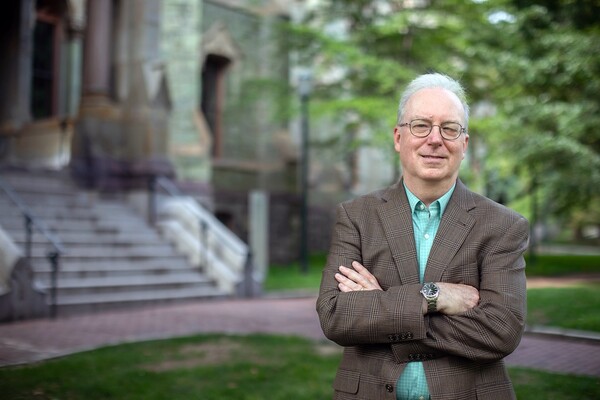
Image: Mininyx Doodle via Getty Images
For most people, “radio” is something that is listened to. For physicists and astronomers, however, “radio” is something that is seen.
Radio waves are part of the electromagnetic spectrum, of which visible light is but a small part. The difference between blue and red light is that the latter is made of waves with longer lengths and lower frequencies. Keep going beyond what the naked eye can sense, and one finds radio waves.
A dozen local high school students did just that this summer, as part of Penn’s Summer Science Academy Program. At the Experimental Physics Research Academy, they worked with James Aguirre, associate professor in the School of Arts & Sciences’ Department of Physics and Astronomy, to turn a decommissioned TV satellite dish on the roof of The Enterprise Center in West Philadelphia into a 30-foot radio telescope, dubbed the Philadelphia Community Radio Telescope.
Aguirre is laying the foundation of a science project that, despite having several tons of hardware at its heart, nevertheless has components that can be taken to local schools in a backpack. Using electronics kits that can be assembled without tools, students are getting a look at a side of the universe that’s invisible to the naked eye.
Aguirre’s summer students first learned the basics of radio astronomy using home satellite dishes. The physical principles that allow them to collect radio waves and the electronics that amplify and manipulate them into pictures are the same, though size matters when it comes to what those pictures look like.
Partnering with The Enterprise Center, a nonprofit organization that cultivates and invests in minority entrepreneurs to inspire working together for economic growth in communities, was critical for helping students make the connection between the different electromagnetic waves celestial objects emit.
“The way that radio telescopes work, it’s hard to get good images,” Aguirre says. “For example, I've taken students up to the roof of Rittenhouse Labs with a 10-inch optical telescope and taken great pictures of a supernova; you can get a lot of high-resolution information with relatively modest equipment. But because the wavelengths of radio are so much longer, you need something like a 30-foot dish to get images that actually look like something."
Originally designed to receive signals from a geostationary satellite for WHYY’s radio station, the dish atop The Enterprise Center can’t be repositioned. For radio astronomy, however, this is not unusual. Owing to their size, many radio telescopes simply ride along with the rotation of the Earth, passively pointing at different regions of the sky.
Aguirre’s own research, recently bolstered by an NSF CAREER Award, involves using arrays of hundreds of small, stationary radio telescopes to probe the early universe. For his high-school students, simply processing the images and stitching them together to get a glimpse of radio-wave-emitting galaxies was a sufficient introduction.
“You end up getting a strip of sky that’s passing overhead,” Aguirre says. “The idea is that we will make a website that shows what the telescope is looking at now, processing the signals being received in real time.”
Aguirre is now taking his radio telescope project on the road, helping the astronomy club at Boys’ Latin of Philadelphia Charter school build their own dishes. A collaboration with its robotics club will attach the dishes to computer-controlled mechanisms that will enable them to be automatically repositioned.
Aguirre’s hands-on curriculum is designed to be as open and flexible as possible. He plans to use it in his Intro to Astrophysics course at Penn, but the main benefit is increasing access to astronomy tools for science students throughout the region.
“We wanted to make it so anyone can plug their electronics into either the big dish or the little portable ones,” Aguirre says. “They can use it for undergraduate or high school classes, as well as demos and science outreach events.”
Evan Lerner

Image: Mininyx Doodle via Getty Images

nocred

Image: Pencho Chukov via Getty Images

Charles Kane, Christopher H. Browne Distinguished Professor of Physics at Penn’s School of Arts & Sciences.
(Image: Brooke Sietinsons)